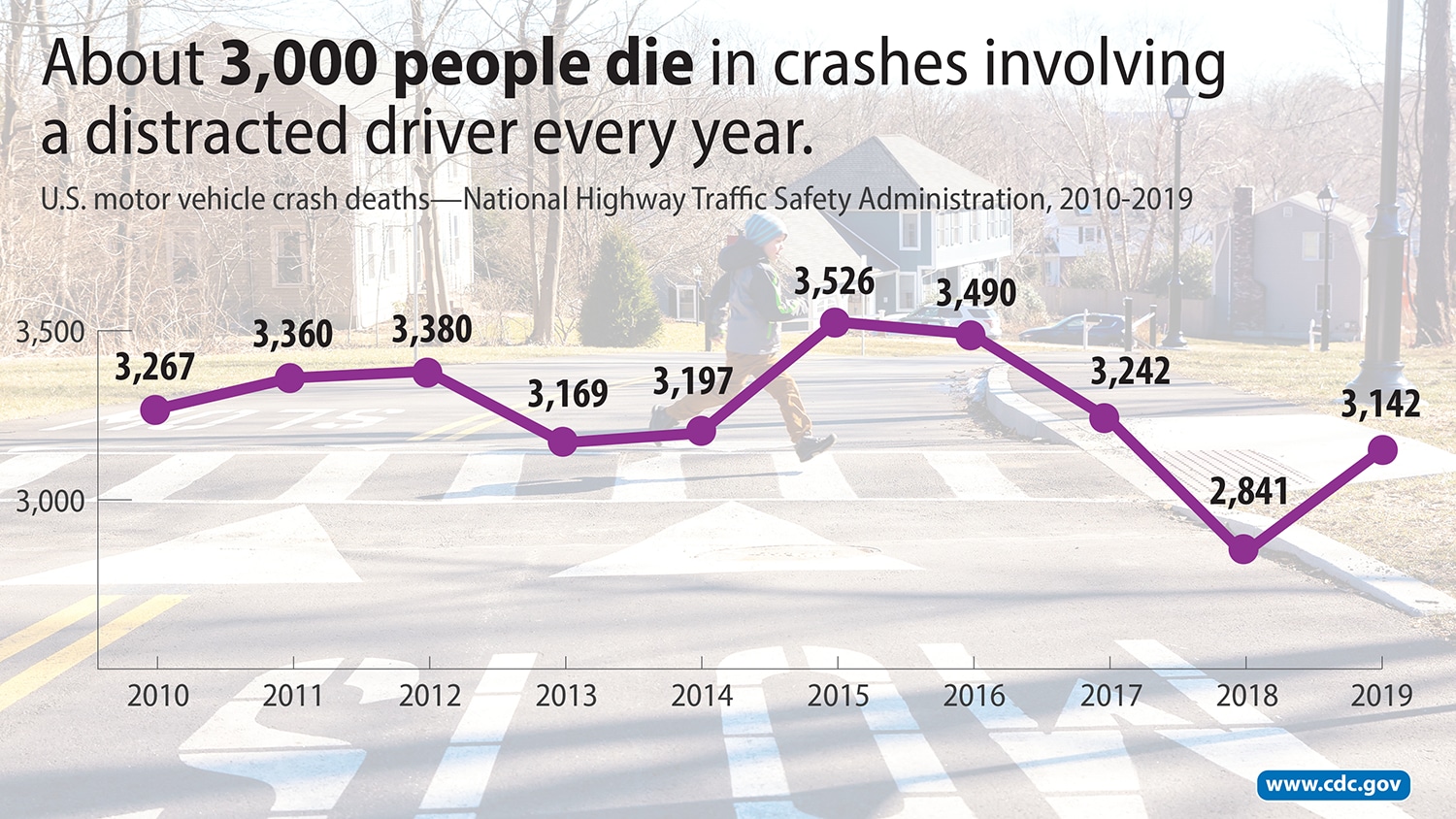Key points
- Anything that takes your attention away from driving can be a distraction.
- Distracted driving can increase the chance of a motor vehicle crash.
- Distracted driving is preventable. Do not multi-task while driving.
Overview
Distracted driving is doing another activity that takes the driver's attention away from driving. Distracted driving can increase the chance of a motor vehicle crash.
There are three main types of distraction:1
- Visual: taking your eyes off the road
- Manual: taking your hands off the wheel
- Cognitive: taking your mind off driving
Sending a text message, talking on a cell phone, using a navigation system, and eating while driving are a few examples of distracted driving. Any of these distractions can endanger you, your passengers, and others on the road.
Impact
Distracted driving impacts thousands of Americans each year.
- Nine people in the United States are killed every day in crashes that are reported to involve a distracted driver.2
- In the United States, over 3,100 people were killed and about 424,000 were injured in crashes involving a distracted driver in 2019.2
- About 1 in 5 of the people who died in crashes involving a distracted driver in 2019 were not in vehicles―they were walking, riding their bikes, or otherwise outside a vehicle.2

Sources: National Highway Traffic Safety Administration, 2010-2013, 2014–2018 and 2019
You can visit the National Highway Traffic Safety Administration (NHTSA) website for more information on how data on motor vehicle crash deaths are collected and the limitations of distracted driving data.
People at increased risk
Young adult and teen drivers are more at risk for distracted driving than other age groups. Among fatal crashes involving distracted drivers in the U.S. in 2019 a higher percentage of drivers ages 15–20 were distracted than drivers age 21 and older.2
Keep reading: Distracted Driving Risk Factors
What's being done
State and Federal efforts to prevent distracted driving include:
- Many states have enacted laws to help prevent distracted driving.
- While the effectiveness of cell phone and texting laws requires further study, high-visibility enforcement efforts for distracted driving laws can be effective in reducing cell phone use while driving.34
- NHTSA has several campaigns to raise awareness of the dangers of distracted driving, including their annual "U Drive. U Text. U Pay." campaign, which began in April 2014.
Keep reading: Preventing Distracted Driving
What you can do
Drivers should not multitask and can use apps to help avoid cell phone use while driving.
Passengers can speak up if the driver is distracted and can assist with navigation or other tasks.
Parents can set consequences for distracted driving and set an example by keeping their eyes on the road and their hands on the wheel while driving.
Keep reading: What You Can Do to Prevent Distracted Driving
Resources
Distracted Driving Fact Sheet
This fact sheet provides an overview of distracted driving and promising strategies that are being used to address distracted driving.
Distracted Driving Summary Fact Sheet
Additional resources
- CDC MMWR – Transportation Risk Behaviors Among High School Students — Youth Risk Behavior Survey, United States, 2019
- CDC MMWR – Mobile Device Use While Driving — United States and Seven European Countries, 2011
- NHTSA – Distracted Driving
- Governors Highway Safety Association – Distracted Driving
- Insurance Institute for Highway Safety – Distracted Driving
- World Health Organization – Mobile Phone Use: A Growing Problem of Driver Distraction
- National Institute for Occupational Safety and Health (NIOSH) – Distracted Driving at Work
- National Highway Traffic Safety Administration (NHTSA) – Campaign Materials
- National Highway Traffic Safety Administration. (2010). Overview of the National Highway Traffic Safety Administration's Driver Distraction Program (DOT HS 811 299) [PDF – 36 pages]. U.S. Department of Transportation, Washington, DC. Accessed 8 February 2022.
- National Highway Traffic Safety Administration. (2021). Traffic Safety Facts Research Note: Distracted Driving 2019 (DOT HS 813 111). Department of Transportation, Washington, DC: NHTSA. Accessed 8 February 2022.
- Chaudhary, N.K., Connolly, J., Tison, J., Solomon, M., & Elliott, K. (2015). National Highway Traffic Safety Administration. Evaluation of the NHTSA Distracted Driving High-Visibility Enforcement Demonstration Projects in California and Delaware [PDF – 72 pages] (DOT HS 812 108). U.S. Department of Transportation, Washington, DC.
- Chaudhary, N.K., Casanova-Powell, T.D., Cosgrove, L., Reagan, I., & Williams, A. (2012). National Highway Traffic Safety Administration. Evaluation of NHTSA Distracted Driving Demonstration Projects in Connecticut and New York [PDF – 80 pages] (DOT HS 811 635). U.S. Department of Transportation, Washington, DC.
